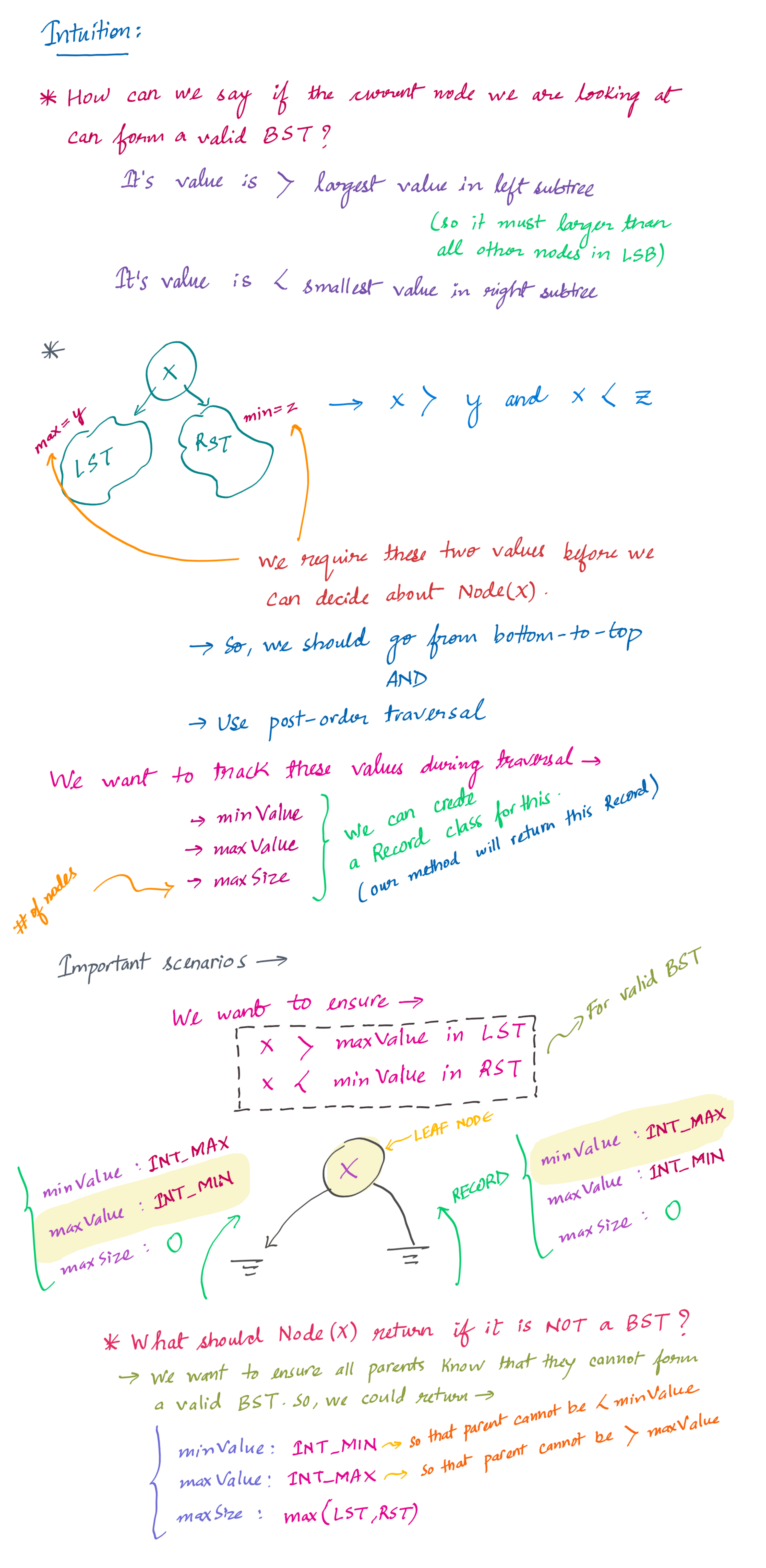PROBLEM DESCRIPTION
Given a binary tree. Find the size of its largest subtree which is a Binary Search Tree. Note: Here Size equals the number of nodes in the subtree.
SOLUTION
BRUTE-FORCE
1
2
3
4
5
6
7
8
9
10
11
12
13
14
15
16
17
18
19
20
21
22
23
24
25
26
27
28
29
30
31
32
33
34
35
36
37
38
39
40
41
42
43
44
45
46
47
48
49
50
class Solution{
static int MIN = 0;
static int MAX = 1000001;
// return the size of the largest sub-tree which is also a BST
static int largestBst(Node root)
{
if(root == null)
return 0;
// if root is already a valid BST, then we don't need to check its sub trees since they cannot has larger size
if(isBST(root, MIN, MAX))
return size(root);
return Math.max(largestBst(root.left), largestBst(root.right));
}
// get the number of nodes in the current binary tree
static public int size(Node root){
if(root == null)
return 0;
int lst = size(root.left);
int rst = size(root.right);
return 1 + lst + rst;
}
// check if the current binary tree is a valid BST
static public boolean isBST(Node root, int minVal, int maxVal){
if(root == null)
return true;
// as per the example, duplicates should go to left tree
if(root.data < minVal || root.data >= maxVal)
return false;
// since duplicates are allowed and they need to go to left tree
// we set the maxValue on left to be the same as current root value
boolean lst = isBST(root.left, minVal, root.data);
boolean rst = isBST(root.right, root.data+1, maxVal);
return lst && rst;
}
}
OPTIMIZED
Good Explanation - takeUForward

1
2
3
4
5
6
7
8
9
10
11
12
13
14
15
16
17
18
19
20
21
22
23
24
25
26
27
28
29
30
31
32
33
34
35
36
37
38
39
40
41
42
43
44
45
46
47
48
49
50
51
52
53
54
55
56
57
58
59
class Solution{
static int MIN = Integer.MIN_VALUE;
static int MAX = Integer.MAX_VALUE;
static int largestBst(Node root)
{
return largestBstHelper(root).maxSize;
}
static Record largestBstHelper(Node root){
// root == null is actually a valid BST with size 0
// we want its parent (if there is any) to take this as a valid BST when comparing
// Let's say the value of parent node is X
// so, we want: x > maxValue in LST and x < minValue in RST
// If we set maxValue to be INT_MIN, and minValue to be INT_MAX, the above should be true
if(root == null){
return new Record(MAX, MIN, 0);
}
// post-order
// why?
// we will need the values of min and max from both LST and RST before evaluating the current node
Record left = largestBstHelper(root.left);
Record right = largestBstHelper(root.right);
// validate the tree formed using current node
// if the value at current node is more than the largest value on left sub tree
// and
// if the value at current node is less than the smallest value on the right sub tree
// then the current node must be forming a valid BST
if(root.data > left.maxValue && root.data < right.minValue){
return new Record(Math.min(root.data, left.minValue), Math.max(root.data, right.maxValue), 1 + left.maxSize + right.maxSize);
}
// it's not a BST
return new Record(MIN, MAX, Math.max(left.maxSize, right.maxSize));
}
}
class Record{
int minValue;
int maxValue;
int maxSize;
Record(){}
Record(int minValue, int maxValue, int maxSize){
this.minValue = minValue;
this.maxValue = maxValue;
this.maxSize = maxSize;
}
}
